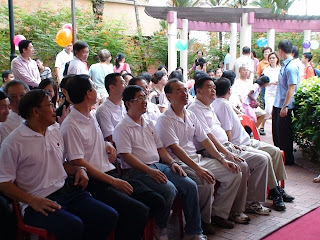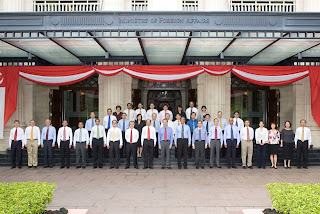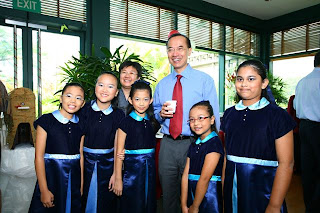[6th World Malayalee Conference]SPEECH BY GEORGE YEO, MINISTER FOR FOREIGN AFFAIRS AT THE 6TH WORLD MALAYALEE CONFERENCE ON 22 AUGUST 2008 AT 2.30 PM AT ORCHID COUNTRY CLUB
Ladies and Gentlemen,
Dear Friends,
Namaskaram
1. Let me first welcome all those who have come to Singapore for this 6th World Malayalee Conference from far and near. We are delighted to play host. Singapore is after all an important node in the Malayalee worldwide web.
2. Having so many Malayalee friends and having to work with so many Malayalees internationally, I have long wondered how the Malayalees have come to be such a talented tribe, or should I say conferederation of tribes, with a cosmopolitan outlook making them ideally suited for the opportunities which globalisation brings.
3. When I first heard of Kerala's self-description: 'God's Own Country', I thought, hmm, quite an extravagant claim. But mulling it over, there is some justification. And one can view it from different perspectives.
4. Last week, I met a Christian Malayalee pastor who told me that his ancestor was a Brahmin who converted to Christianity by the Apostle Thomas himself two thousand years ago. Of course, Thomas went there because there was already a thriving Jewish community in Cochin long before that. Adi Sankaracharya, one of the most important teachers in Hinduism who set up the four peethas in the four corners of India, was born in Kaladi in the 8th century. The Ayappan temple in the western ghats is one of the holiest in India. Whether it is Hinduism, Judaism, Christianity or Islam, the Malabar coast has a long tradition of hosting ancient religious communities going way back. So, maybe, it is God's own country after all.
5. When I first visited Trivandrum with my wife in 1986, we were struck by how lush and green the land was and how much it resembled peninsular Malaysia. I think it must be the greenness of the land that gave kathakali its unique character. The coconut trees, the backwaters, the people all seemed strangely familiar. Confronted by some rubbish outside the zoo, the tour guide quickly blamed migrant workers from a neighbouring state. With high educational attainments and strong international connections, the Malayalees are rightly proud of their own history, culture and identity even though they may belong to different sub-groups.
6. Over the centuries, sandwiched between the Arabian Sea and the western ghats, the monsoons have brought to the shores of Kerala all kinds of foreign influences which have inter-mingled with the ancient traditions of India to create a special breed of high performers. The same monsoons facilitated the journeys of Malayalee men overseas in search of fame and fortune. A strong matrilineal culture ensured that families stayed strong even when fathers were away for long periods.
7. During the Raj, many came to British Malaya and Singapore. Educated and speaking English, they became clerks, teachers and junior assistants to the British in the plantations, towns and cities, both in government and in the private sector. With strong families and strong emphasis on education, their descendants continue to do well in independent Malaysia and Singapore.
8. The same story is repeated in the US, Europe, the Middle East and India itself. So many of India's most prominent diplomats are Malayalee. Without the Malayalees working in the Gulf states, the economies there will grind to a halt.
9. Singapore's Malayalee links to India, the Middle East, Europe and the US are natural ones which the World Malayalee Conference should help to invigorate.
10. Looking ahead, the rise of China will open a new chapter in the fascinating history of the Malayalee people. It is not a new story because Malabar's links with China are old ones. The origins of Chinese shaolin gungfu in kalaripayatthu are well known. Many Chinese are familiar with the story of how Bodhi Dharma brought the martial art from India to China but most do not know that it came from Kerala. Many Chinese would be surprised to learn that the beautiful fishing nets in Kerala came from China but all Malayalees know that. In the early fifteenth century, the treasure ships of the Ming Admiral Zheng He visited the ports of the Malabar coast on all their voyages. The official annal, The Overall Survey of the Ocean Shores, recorded the Admiral's visit to Calicut, and how having given imperial honours to the king, Vana Vikraman, the Admiral also erected a pavilion with a ceremonial stone tablet. The king, actually the zamorin, was described as a Brahmin and a Buddhist, and had Muslim chiefs. The Chinese observed that when the zamorin died, the throne was passed to his sister's son. They also noted that the people of Calicut were honest and trustworthy.
11. At the ports of Calicut and Cochin, with Malayalees playing host and middlemen, the Chinese met Arab, Iranian and Venetian traders. Here were communities with deep links to East and West, benefiting from the exchange of goods, techniques and ideas. That is all part of the Malayalee DNA which should serve the community well in the coming years.
12. I believe Singapore will play an important role in this next phase because we are strategically positioned in between India and China. Indeed Singapore was established as a trading post of the British East India Company from Calcutta precisely to service India's China trade. India was the jewel in the crown, and China was India's biggest trading partner. In the new East-West trade of the 21st century, Singapore will again play this role. The Indian community in Singapore is growing faster than any other community for this reason.
13. In October, the first Pravasi Bharatiya Divas or Overseas Indian Diaspora Conference will be held in Singapore. The theme is 'Towards a Dynamic Diaspora'. The Malayalees have gone beyond that because it always had a dynamic diaspora. I welcome all of you to this World Malayalee Conference and wish you a very successful meeting. I also wish all Malayalees a Happy and Bountiful Onam next month.


 Do also read my posts on Beyond SG
Do also read my posts on Beyond SG



























